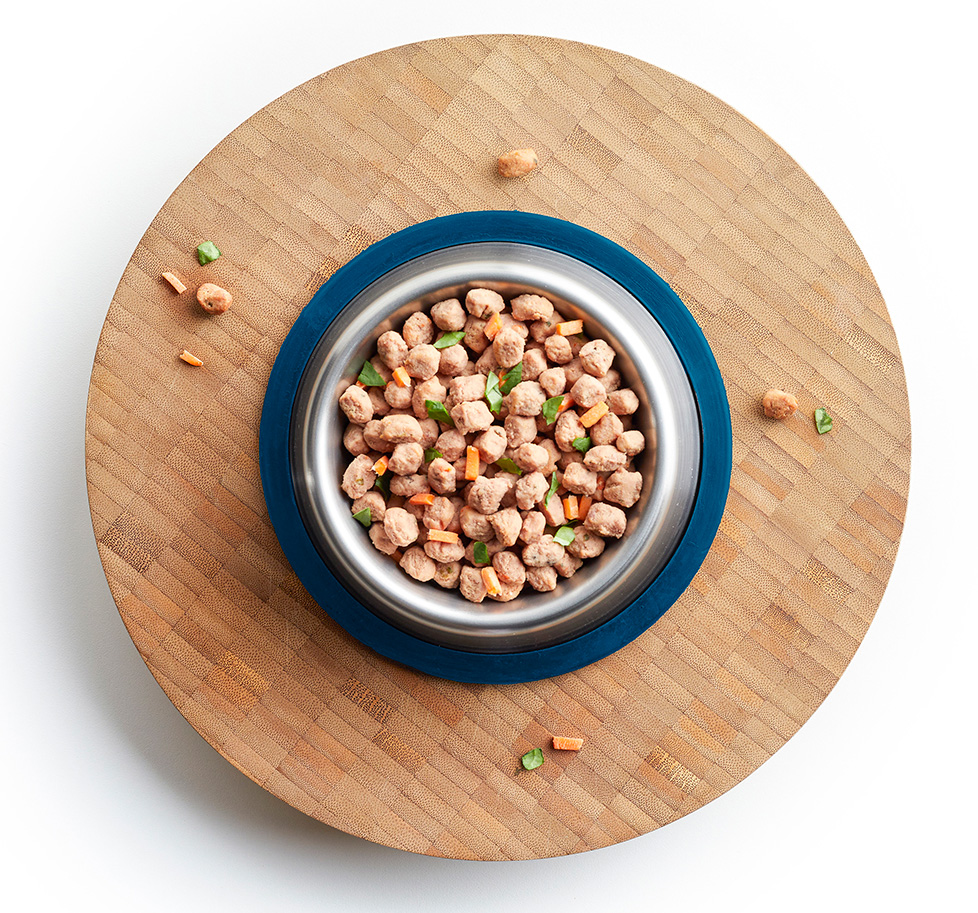This article was published in the May 2024 issue of Pet Food Processing. Read it and other articles from this issue in our May digital edition.
Oxidation poses a significant challenge in pet food production, affecting color, flavor and nutritional value, which in turn influences shelf life and palatability. As a result, pet food formulators must collaborate with ingredient suppliers to find effective solutions for addressing this potentially harmful and costly issue.
Oxidation is a chemical reaction that occurs when vital nutrients in pet food, such as fats, proteins and vitamins, come into contact with oxygen. This reaction can occur during the manufacturing process or after the food has been packaged, leading to a range of negative effects.
Firstly, oxidation can affect the palatability of pet food, making it less appealing to pets. The nutritional value of pet food can also be compromised by oxidation, and pets can experience gastrointestinal problems or nutritional deficiencies if they consume oxidized food regularly.
“Oxidation can impact palatability by causing off-flavors, colors and aromas,” said Robert Mason, senior applications scientist, Balchem, Montvale, NJ. “Wide-spread oxidation can also impact nutrition as reactive micronutrients are consumed or compromised. Finally, consuming rancid product can cause gastric upset in pets leading to vomiting and diarrhea. In many cases, our pets will tell us long before we can detect rancidity. Many pets will display decreased excitement at mealtime, slower response to engage the bowl, and potentially decreased voluntary intake.”
The degradation of key nutrients due to oxidation is of particular concern, as these nutrients play essential roles in maintaining the health and wellbeing of pets. For example, certain vitamins are prone to oxidation, which can lead to a decrease in their bioavailability and effectiveness in supporting various bodily functions.

Oxidation can affect the flavor, texture, aroma and even the nutritional quality of pet food.
|“The influence of oxidation on pet food quality and safety is multifaceted, impacting various aspects such as flavor, texture, aroma, and most critically, the nutritional integrity of the product,” said Parastou Farshi, scientist, Corbion, Lenexa, Kan. “Oxidation, in simple terms, is a chemical reaction involving the transfer of electrons, which can lead to the degradation of fats, proteins and vitamins present in pet food. This degradation not only compromises the sensory attributes of the food but also diminishes its nutritional value, potentially posing health risks to pets if consumed.”
When it comes to health risks, oxidation can lead to the formation of harmful compounds such as free radicals and peroxides. These compounds can damage cells, tissues and organs, leading to inflammation, oxidative stress and even chronic diseases.
“When pet food is exposed to oxygen and light, lipid radicals and lipid-peroxide radicals (missing hydrogen) form; they are highly reactive and toxic when our endogenous system is insufficient to protonate them,” explained Michael A. Rogers, Ph.D., professor, department of food science, University of Guelph, Ontario. “Once this reaction is initiated, it propagates spontaneously, producing more radicals and lipid hydroperoxides. As more radicals form, other molecules have hydrogen extracted, such as proteins, DNA and RNA, which leads to carcinogenic mutations over the long term. Therefore, radicals themselves are toxic. Additionally, the lipid-hydroperoxides decompose into fragments of lipids (shorter fatty acids, aliphatic molecules, alcohols, aldehydes and ketones), each with potential health effects.”
Early detection and preventive measures
In order to effectively tackle oxidation, it’s essential for pet food processors to understand the factors that contribute to the process and how to prevent it.
“Oxidation is a complicated and irreversible process that can be influenced by many factors, such as temperature, humidity, light, oxygen, metals and enzymes,” said Jim Mann, global platform manager of antioxidants and food safety, Kemin Industries, Des Moines, Iowa. “The rate and extent of oxidation can vary depending on the type, quality and composition of pet food ingredients, as well as the processing, formulation, packaging, storage and handling conditions. Therefore, it is important to monitor for early signs of oxidation in pet food products.”
A combination of sensory evaluation and chemical analysis can help pet food manufacturers identify early signs of oxidation. Together, these methods can detect changes in appearance, flavor and odor, as well as measure levels of primary and secondary oxidation products.
“To detect early signs of oxidation, pet food and ingredients are often tested for chemical signs of oxidation, such as peroxide values or aldehyde formation. Along with visual and sensory observations, these can serve as important tools for ensuring quality of raw materials and achievement of desired shelf life,” Mann said.

Balchem offers organic trace minerals (proteinates and chelates) that bind to a protein ligand to increase bioavailability and decrease oxidation-reduction reactions, which could lead to reduced product stability and/or rancidity.
|Aside from monitoring and early detection, processors can also implement various strategies and technologies to combat oxidation.
“Innovative strategies to address oxidation in pet food formulations involve capitalizing on the effectiveness of natural antioxidants,” Farshi said. “These antioxidants, derived from various sources such as plant extracts, herbs and spices, possess inherent properties that can help mitigate the detrimental effects of oxidation on pet food quality and safety.”
“Antioxidants are well-known substances that can inhibit or delay the oxidation process by scavenging free radicals that are generated during the oxidation process,” Mann added. “As consumer demand for natural and label-friendly ingredients has grown, there is significant focus on innovation with natural antioxidants. The drive for sustainability is pushing companies to look at how they produce natural antioxidants, finding more sustainable solutions to improve them, or even to replace synthetic antioxidants.”
Packaging materials also play a crucial role in preventing oxidation. Oxygen barriers, such as nitrogen flushing and barrier films, can help reduce the amount of oxygen that comes into contact with the product. Additionally, light-blocking materials can prevent harmful UV rays from causing oxidation in pet food. These innovative packaging solutions can help extend the shelf life of pet food and maintain its quality and nutritional value.
The role of ingredient suppliers
Alongside the efforts of pet food processors, ingredient suppliers also play a crucial role in combating oxidation. Some of the ways they can contribute include offering high-quality ingredients with lower oxidation risk, supplying natural antioxidants, and providing technical support and guidance to processors.
“Ingredient suppliers can provide both the antioxidant products and technical solutions to utilize them, as well as supplying ingredients that are used to formulate pet food products that may contribute to the oxidation risk,” Mann explained. “They play a crucial role at the front end of the process to manage oxidation in pet food formulations through the quality of the ingredients. Proper management of the raw materials can influence the quality, palatability, safety and stability of the final pet food products.”
As suppliers of antioxidants, ingredient providers play a pivotal role in ensuring the safety and quality of pet food.
“To ensure proper shelf life and long-term stability for various products, it is critical to control numerous oxidative-reduction reactions in the products. Our [Balchem’s] products help provide a foundation for traditional antioxidants to best perform,” Mason said.
“We offer encapsulated acidulants for pH control without the negative impact on protein quality that can result in poor stability and organoleptics. We also offer chelated minerals to prevent reactions, as well as encapsulated ascorbic acid for Vitamin C fortification, which can also serve to delay some antioxidation properties,” he added.
Ingredient suppliers can also collaborate with processors to develop new and innovative solutions that address the ever-evolving challenges of oxidation.
“By supplying natural antioxidant blends, ingredient providers contribute to enhancing the stability and shelf life of pet food,” said Parastou Farshi, Corbion.
“By supplying natural antioxidant blends, ingredient providers contribute to enhancing the stability and shelf life of pet food,” Farshi said. “Through rigorous quality control measures and collaboration with pet food manufacturers, ingredient providers ensure the freshness, potency and efficacy of these natural antioxidant blends. This collaboration enables manufacturers to optimize formulations, tailor ingredient blends to specific product requirements, and implement preventive measures to mitigate oxidation risks throughout the supply chain. By leveraging natural antioxidant blends, ingredient providers help pet food manufacturers create products that meet consumer demand for natural and minimally processed options while effectively addressing oxidation concerns.”
In addition to providing antioxidants, the partnership between ingredient suppliers and pet food manufacturers extends to refining production and storage processes. This collaborative effort aims to shield pet food from oxygen, light and excessive heat from ingredient refinement to packaging.
“Since many ingredients have extended shelf life, the packaging (UV and O2 barrier) and storage conditions (cold, dark and dry) are paramount from refinement to formulation,” Rogers said. “During refinement (e.g., to produce oil), it is key to remove pro-oxidants, such as chlorophyll and iron, which also remove antioxidants but are often supplemented back to refined oils. Also, the deactivation of endogenous oxidative enzymes is paramount.”
Extending shelf life
Ultimately, the goal of addressing oxidation in pet food is to extend shelf life and maintain product quality and safety. This in turn benefits both manufacturers and consumers by reducing waste, ensuring product consistency, and meeting the needs and expectations of pet owners.
“Extending the shelf life of pet food while maintaining its nutritional value and palatability is a key objective and challenge for pet food manufacturers, as it can ensure the wellbeing of the pets,” said Jim Mann, Kemin Industries.
“Pet foods have a unique characteristic in that they require 12 to 18 months of shelf life and sometimes up to even two years. It is important to understand that during this time the product must be stored until consumption without losing its quality, nutritional value, safety and acceptability,” Mann said. “Extending the shelf life of pet food while maintaining its nutritional value and palatability is a key objective and challenge for pet food manufacturers, as it can ensure the wellbeing of the pets.”
To achieve these goals, it is essential for pet food manufacturers to implement a comprehensive approach to addressing oxidation. This includes utilizing high-quality ingredients with low oxidation risk, incorporating natural antioxidants into formulations, and implementing proper packaging and storage techniques.
Read more about pet food safety on our Operations page.




